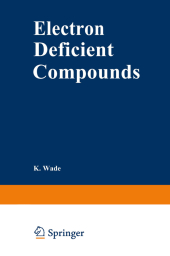 Neuerscheinungen 2012Stand: 2020-01-07 |
Schnellsuche
ISBN/Stichwort/Autor
|
Herderstraße 10
10625 Berlin
Tel.: 030 315 714 16
Fax 030 315 714 14
info@buchspektrum.de |

Kenneth Wade
Electron Deficient Compounds
Softcover reprint of the original 1st ed. 1971. 2012. vii, 203 S. 192 SW-Abb. 229 mm
Verlag/Jahr: SPRINGER, BERLIN; SPRINGER US; SPRINGER 2012
ISBN: 1-468-46056-0 (1468460560)
Neue ISBN: 978-1-468-46056-8 (9781468460568)
Preis und Lieferzeit: Bitte klicken
This book is about compounds such as the boron hydrides and associated metal hydrides and alkyls which acquired the label ´electron deficient´ when they were thought to contain too few valence electrons to hold together. Though they are now recognized as containing the numbers of bonding electrons appropriate for their structures, the term ´electron deficient´ is still commonly applied to many substances that contain too few valence electrons to provide a pair for every pair of atoms close enough to be regarded as covalently bonded. The study of such substances has contributed much to chemistry. Techniques for the vacuum manipulation of volatile substances were devised specifically for their study; developments in valence theory resulted from considerations of their bonding; and the reactivity of several (for example, diborane and complex metal hydrides, lithium and aluminium alkyls) has made them valuable reagents. The purpose of this book is to provide an introduction to the chemistry of these fascinating compounds. The experimental and spectroscopic methods by which they can be studied are outlined, the various types of structure they adopt are described and profusely illustrated, and the relative merits of extended valence bond and simple molecular orbital treatments of their bonding are discussed, with as liberal use of diagrams and as limited recourse to the Greek alphabet as possible. A recurring theme is the importance attached to considerations of molecular sym metry. Their reactions are treated in sufficient detail to show whether these reflect any deficiency of electrons.
1 Introduction.- 2 Structure and bonding of diborane.- 2-1 Introduction.- 2-2 Elucidation of the structure of diborane.- 2-3 The bonding in diborane.- References.- Problems.- 3 Structures and bonding of some higher boranes and boron polyhedra.- 3-1 Introduction.- 3-2 The structures and bonding of some higher boranes.- 3-3 Topological treatment of boron hydrides.- 3-4 The structure and bonding of pentaborane(9), B5H9.- 3-5 Some examples of boron polyhedra.- References.- Problems.- 4 The general chemistry of the boron hydrides.- 4-1 Introduction : some thermodynamic data.- 4-2 Some vacuum manipulative techniques.- 4-3 Preparation and interconversions of the boron hydrides.- 4-4 Some reactions of diborane.- 4-5 Some reactions of higher boranes.- References.- Problems.- 5 Associated metal hydrides, alkyls, and aryls.- 5-1 Introduction.- 5-2 Associated metal hydrides.- 5-3 Some mixed hydrides.- 5-4 Some polynuclear hydrogen-bridged transition metal carbonyl hydride complexes.- 5-5 Organo-aluminium compounds.- 5-6 Some reactions of aluminium alkyls.- 5-7 Alkyl or aryl bridges involving gallium, indium, and thallium.- 5-8 Organo-beryllium and -magnesium compounds.- 5-9 Alkali metal alkyls.- 5-10 Some carbide structures.- References.- Problems.- 6 Carboranes.- 6-1 Introduction.- 6-2 The dicarba-closo-dodecaboranes, C2B10H12.- 6-3 Other dicarba-closo-boranes.- 6-4 Dicarba-nido-borane anions and their metal complexes.- 6-5 Species containing one cage carbon atom.- 6-6 Carboranes with more than two cage carbon atoms.- References.- Problems.- 7 Other examples of electron deficient bonding.- 7-1 Introduction.- 7-2 Electron deficient bridged carbonium ions.- 7-3 Transition metal cluster compounds.- 7-4 Transition metal-hydrocarbon ?-complexes.- 7-5 Electron deficient sigma bonding in electron rich species 195 References.- Problems.- Answers to Problems.


